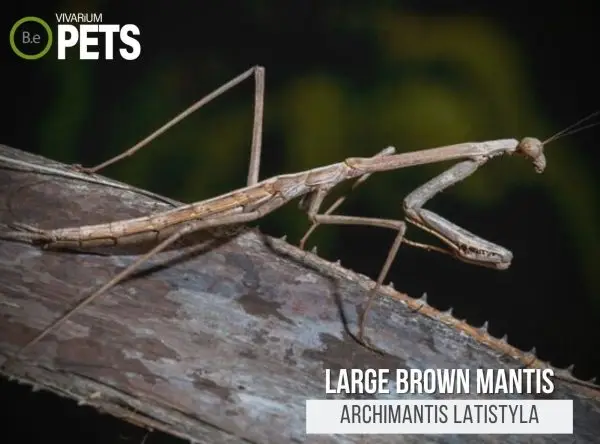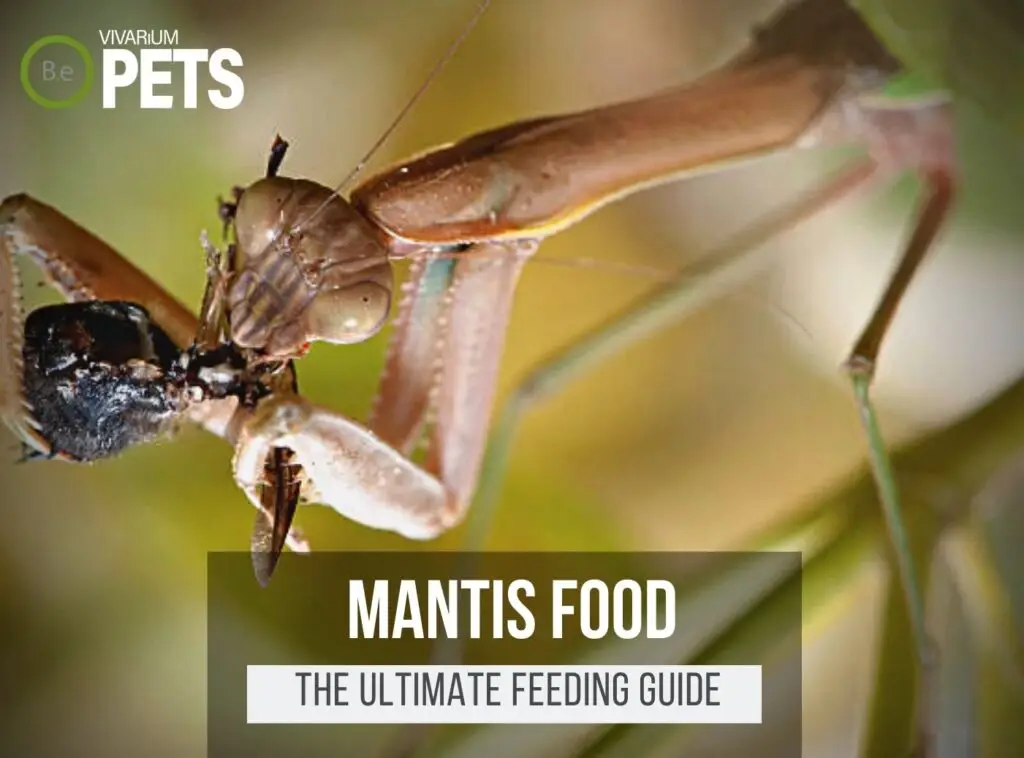Do you enjoy observing the natural world with awe and fascination? Are you interested in taking your animal-keeping journey to the next level?
If you’ve answered yes to either of these questions, then caring for a Large Brown Mantis might be a great fit for you!
This species delivers an exciting mix of beauty and complexity, and caring for them can bring a unique sense of fulfillment.
This Archimantis latistyla care guide will prepare you to do just that by exploring the essential elements of their habitat setup, diet, and breeding habits.
allowing you and your pet praying mantis to thrive together.
Table Of Contents:
ToggleWhat Are Large Brown Mantis?
Archimantis latistyla is a species of insect from the family Mantidae.
These mantises are typically light brown and can reach a length of a few inches.
The common name “Large Brown Mantis” comes from their size and their common coloration.
They are a popular type of mantis for keeping since they are generally hardy and easy to care for despite their intimidating size.
What Does a Large Brown Mantis Look Like?
The Large Brown Mantis has a unique and impressive look, with a body length of up to 4.5 inches.
Its body is mostly dark brown, with yellow, green, and red highlights on its wings.
Its head features two bulging eyes and a large proboscis. Its legs are thin and long, with several segments that allow the mantis to grasp firmly onto its prey.
Its wings are long and narrow, and it displays a menacingly bright stripe on the underside of the wings.
Lastly, Archimantis latistyla has two powerful raptorial forelegs with spikes along their inner sides.
They use these spined legs to capture and hold onto their prey.
Benefits Of Using Large Brown Mantis
The Large Brown Mantis is an excellent choice for those seeking a stunning addition to their vivarium.
Not only can these impressive creatures become a centerpiece in your cage, but their presence can also bring your other pets a sense of companionship and security.
The mantis will establish itself as the ‘top predator’ and can help keep pests out while providing a graceful and fascinating creature to observe.
Furthermore, they are not usually aggressive and can be enjoyed by owners and visitors alike.
With proper care and patience, these mantises can bring an incredible level of beauty and intrigue to all terrariums.

Large Brown Mantis Facts
Archimantis latistyla is an insect native to Australia that is characterized by its impressive wingspan and mottled brown coloration.
This species has a strong voracious appetite for smaller prey and is shy but curious by nature, with a lifespan of several months.
Females of the species are the only ones able to reproduce, laying sticky egg cases called oothecae near the end of their life cycle.
Habitat
The Large Brown Mantis originates from parts of Australia, Papua New Guinea, and New Caledonia.
They inhabit a variety of tropical and subtropical regions at sea level, as well as areas of higher elevation.
In their natural environment, they inhabit many diverse habitats.
These include temperate forests, where they reside on trunks and branches of vegetation in shady areas, along with wettish, temperate forests with an abundance of thick foliage.
They’ve even been observed in eucalyptus groves, and palm trees are another favored habitat.
Archimantis latistyla typically choose an area near the ground where they can position themselves to wait for prey.
Create the perfect home for your mantis with our Customizable Mantis Enclosure Kits, designed to meet all their habitat needs.
Diet
Large Brown Mantes in the wild are typically predatory insects, relying on a diet made up of other insects and other small invertebrates.
Their diets typically consist primarily of spiders and crickets, though they will occasionally supplement them with small ants, moths, butterflies, cocoons, and caterpillars.
These insects must usually be smaller than the praying mantis itself, as they cannot consume larger prey that they cannot physically grab and handle.
In addition to consuming their prey for sustenance, Large Brown Mantes also consume supplementary substances in the form of pollen, sap, and plant juices.
These supplementary substances offer essential vitamins and minerals that may be missing from their chitinous diets.
Temperament
Archimantis latistyla is typically quite shy and wary around humans and other animals.
This species is more likely to hide than confront when they feel threatened. When handled, Large Brown Mantises are usually calm and subdued.
They may attempt to crawl away, however, so it’s a good practice to be gentle and patient when handling them.
This species is also non-aggressive toward other animals, although they may see some of them as potential food sources, so it’s important to monitor interactions between any other animals and your mantis.
In general, the temperament of this species is quite mild and they make a great addition to any insect collection or even as a unique pet.
Lifespan
The Large Brown Mantis has a typical lifespan of between 6-12 months.
As with other species in the Mantodea order, they experience a complete metamorphosis, meaning they transition through many stages – egg, nymph, sub-adult, and adult.
The egg is laid across multiple separate oothecae (clusters of eggs) and can take up to three weeks to hatch.
Newly hatched nymphs look a lot like the adults but they can’t fly and are much smaller.
As they reach the sub-adult stage, they start to gain the ability to fly and can molt several times while they further develop into the adult stage.
As adults, Archimantis latistyla will feed, mate, and reproduce until the end of their life cycle.
To maximize their lifespan, it’s important to provide your mantis with a healthy, balanced diet and an environment ideal for their needs.
Breeding
The Large Brown Mantis is a fascinating species when it comes to mating and reproduction.
Unlike most other mantis species, the Praying Mantis will mate in pairs, with the female leading the way.
It is best to introduce a potential mate into the female’s territory, where they will courtship, and then the female will capture the male.
The male mustn’t be too large compared to the female, as this could result in the female devouring the mate.
Once mating has finished, the female will go on to lay her eggs.
This species of mantis is capable of reaching full maturity in approximately 1-2 months and will become fully mature after multiple molts.
Where To Find Large Brown Mantis
If you’re interested in acquiring Archimantis latistyla, you may be able to find them in the wild or online from potential breeders or retailers.
The natural habitats of this species are rainforests and tropical regions.
Therefore, if you live in a tropical area, you may be able to find them in the wild.
However, it is typically safer and easier to acquire them from breeders or vendors.
In this case, you should conduct thorough research to find reputable breeders or vendors and purchase your mantis from a certified seller.
Furthermore, you should check for signs of health and any issues with the mantis you plan to purchase, such as missing limbs.
Additionally, if you can quarantine the mantis before introducing them into your habitat, it is recommended to do that to ensure the safety of the rest of your colony.
Large Brown Mantis Care
Caring for a Large Brown Mantis requires providing the right environment (temperature, humidity, lighting, and substrate) as well as a suitable diet of insects and supplemental vitamins.
You must also prepare to breed the mantis by understanding mating behavior and setting up a breeding tank.
Lastly, maintaining a healthy mantis requires health care considerations.
With the right information and guidance, you will be ready to enjoy the unique and fulfilling experience of keeping Archimantis latistyla.
Tank Requirements
The ideal tank for a Large Brown Mantis should be well-ventilated, with a secure lid.
A 5-10 gallon tank should be used for adult mantis, with smaller plastic cages or terrariums preferred for juvenile mantis.
The pH should be slightly acidic, around 6.0-7.5.
The hardness of the water should be kept soft, around 75-85 ppm, while the temperature should be kept at 75-85°F.
The terrarium substrate should be kept moist, such as peat moss or coconut fiber, and should be changed regularly.
Terrarium lighting should be provided by either fluorescent fixtures or overhead lighting, with 12 hours of light and 12 hours of darkness recommended to avoid stress and promote melanism in the mantis.
What Does Large Brown Mantis Eat?
Feeding Archimantis latistyla is essential for its health and growth.
Here are some tips for feeding your mantis:
- Offer a variety of food: Offer a variety of small insects such as crickets, grasshoppers, and small cockroaches. To supplement their diet, you can offer small amounts of fruits and vegetables such as apples and squash.
- Properly portion food: Offer food that’s appropriate for your mantis’s size. If they are not able to consume the food within a few hours, remove it from the enclosure.
- Offer food daily: Feed your mantis 1-2 times per day.
- Ensure fresh food: Provide fresh food for your mantis at each feeding. Discard any leftover food after 1-2 hours.
- Don’t overfeed: Feed only as much food as your mantis can consume in a few minutes. If you offer too much food, it can cause health problems and attract pests.
- Supervise feedings: For safety, always supervise feedings to make sure your mantis is not in danger from any of the food items.
If you’re looking for a more detailed approach to feeding these critters, be sure to check out my ultimate DIY Praying Mantis food guide. I give a more in-depth explanation of the best foods and my favorite recipe.
Best Tankmates For Large Brown Mantis
If you are looking for other animals to keep with Large Brown Mantis, you need to be selective with your choices.
This species is aggressive to other arthropods, so it’s best to avoid house spiders, centipedes, and other invertebrates if you want them to live.
Isopods, snails, and millipedes could also be good tankmates for Archimantis latistyla, but remember to provide ample space for all species.
Ultimately, you should choose tankmates that can thrive in the same environment without posing a risk to your Large Mantis.
With a little research and care, you’ll be able to create a harmonious and healthy habitat for your pet.
Conclusion
Caring for Archimantis latistyla can be an incredibly rewarding experience.
They are hardy, beautiful, and witty insects that could make for an interesting addition to your insect collection.
With the right habitat, food, and understanding of their unique needs, you can easily provide a comfortable and stimulating environment for this species to live in so you can enjoy all they have to offer.
When thoughtfully cared for, these creatures can bring hours of fun, education, and intrigue to plenty of lives.
Create the ideal habitat for your praying mantis with our species-specific soil mixes and Insect Enclosure Kits. These products provide everything you need for a thriving Mantid habitat.





